7 Best Risk Intelligence Platforms


Fresh and accurate risk intelligence gives you the foresight to anticipate disruptions, monitor threats, and make smarter business decisions.
Whether it leverages extensive datasets, real-time alerts, or smart workflows, each risk intelligence tool on this list excels in delivering actionable risk insights.
But which platform is the best fit for your risk priorities and operating environment?
This guide will help you compare key strengths and limitations, so let’s dive right in.
Veridion is an AI-powered business intelligence platform that transforms risk management and strategic planning with actionable, in-depth insights.
Whether it’s streamlining third-party risk assessments or conducting supply chain and technology mapping, Veridion caters to a variety of industries and use cases thanks to its expansive database.
With 134+ million public and private company profiles and 320+ enriched company attributes, all the data you need is at your fingertips.
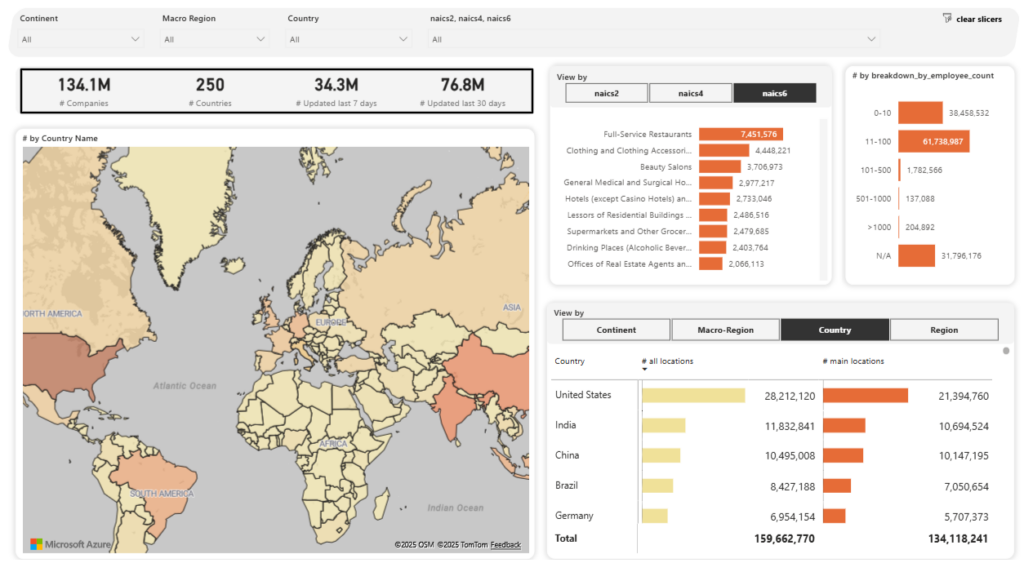
Source: Veridion
The platform’s engine continuously refreshes these profiles at a global scale, transforming raw data into structured, real-time intelligence to help you anticipate and mitigate risks, be they third-party related or more operational.
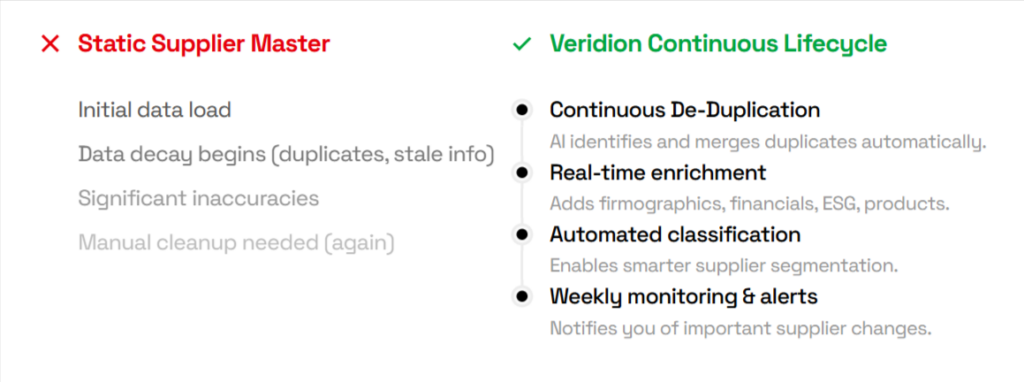
Source: Veridion
Intelligence is organized into intuitive dashboards that support natural language queries and can be easily integrated into your existing ecosystems.
Through APIs or bespoke setup options, you can embed risk intelligence directly into ERP, procurement, or governance platforms, preventing data silos, duplications, and inefficiencies.
Veridion’s data coverage spans across essential risk categories like financials and ESG insights, along with granular product- and service-level data and full corporate hierarchies.
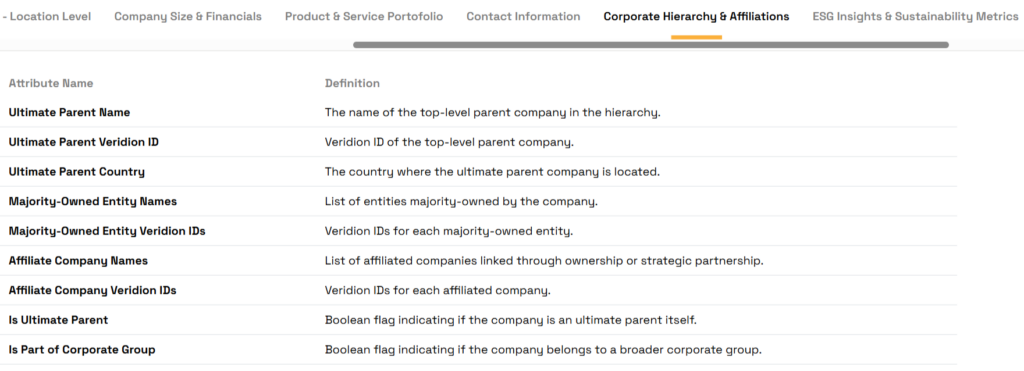
Source: Veridion
While it doesn’t provide built-in risk scoring or regulatory workflow automation, Veridion’s uniqueness lies in its versatility.
Ongoing risk monitoring requires fresh data and thorough data enrichment, but when existing partners become a liability, you still need to scramble for alternatives.
Unless you’re using Veridion.
Scout Discovery enables teams to instantly switch to sourcing and identify ideal candidates, even for highly specialized searches.
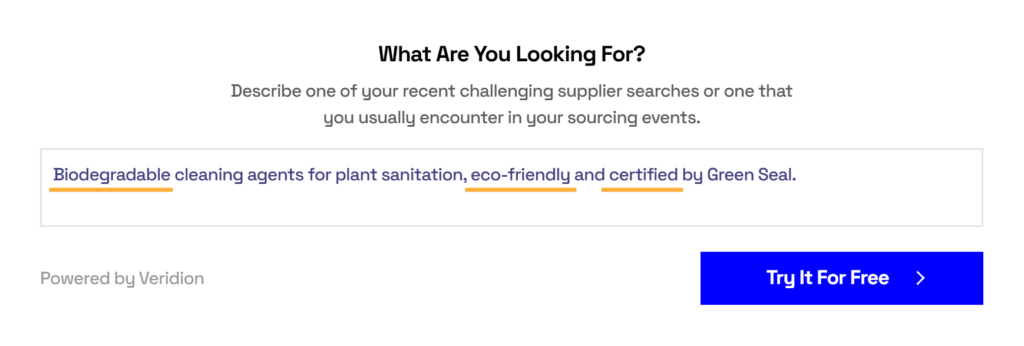
Source: Veridion
All in all, by combining vast data coverage with flexible delivery, Veridion empowers companies to shift from reactive risk management to building resilient, forward-looking operations.
Sounds intriguing?
With utility-based pricing and plenty of data samples for you to explore, be sure to get in touch with our team first, and we’ll take it from there.
Business Radar is an all-in-one risk management platform focusing on adverse media and UBU screening, as well as enhanced due diligence for third parties.
In addition to providing access to 1,200+ sanctions and enforcement lists and politically exposed person (PEP) registries, the platform’s standout feature is its adverse media screening engine.
By continuously monitoring over 154 million global sources, from regional news outlets to regulatory websites, you can capture any instance of ESG violations, legal exposure, financial distress, and more.

Source: Business Radar
Since articles are automatically clustered by topic, volume, and period, users gain a comprehensive timeline of a company’s (negative) publicity.
More importantly, the ability to visually track risk spikes and flag underlying drivers enables you to anticipate further reputational shifts.
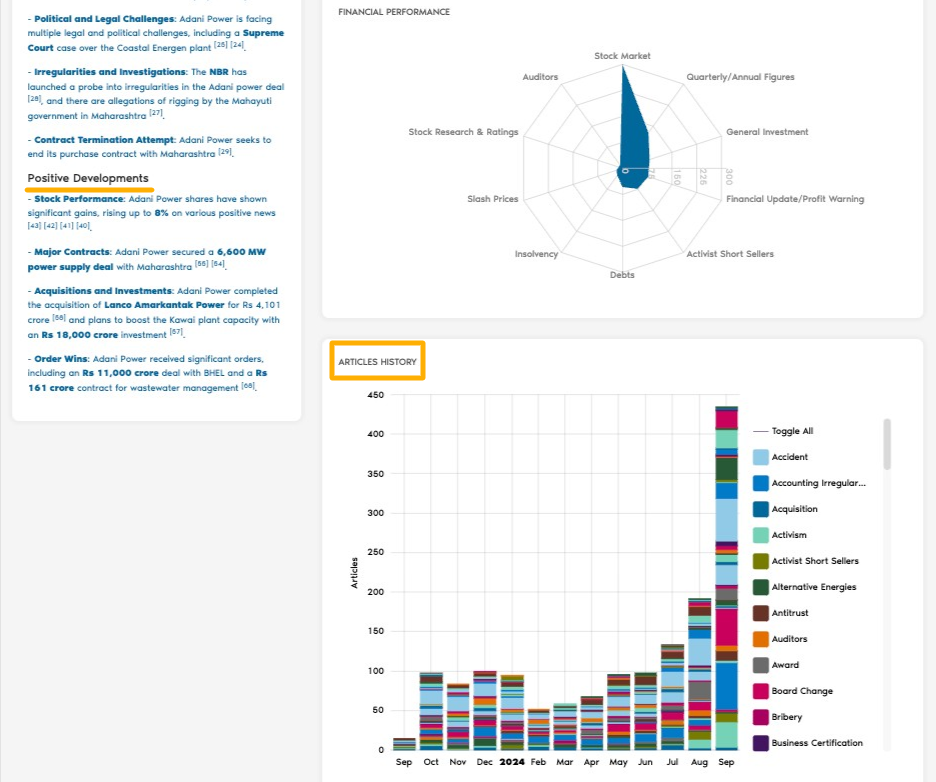
Source: Business Radar
These capabilities are further complemented with highly configurable alerts that can be applied across entire industries, by country, or only on chosen portfolios.
However, since Business Radar focuses heavily on its monitoring scope, it offers fewer workflow and integration capabilities, which are also limited to the premium plan.
Users are hinting at some usability issues, but given the small review sample, this should be taken with a grain of salt.
Pricing starts at €450 per month, and while you’ll need to reach out for a quote, all three of Business Radar’s subscription tiers offer real-time media monitoring, screenings, and alerts.
However, the number of users and entities you can monitor is fairly limited unless you opt for the Enterprise plan.
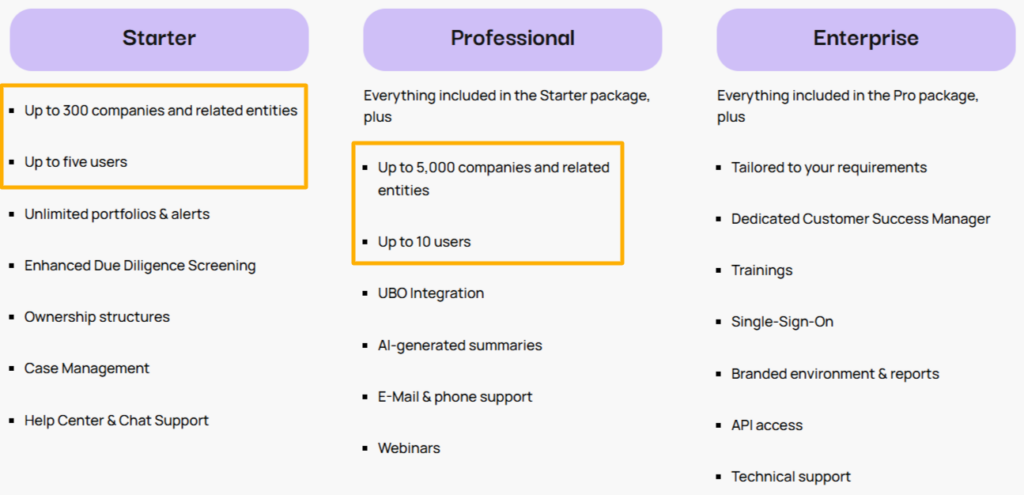
Source: Business Radar
All in all, if you’re looking for a platform that focuses on reputational risk intelligence while automating key due diligence checks, Business Radar is an option worth considering.
Moody’s cloud-based Intelligent Risk Platform (IRP) caters to insurers, reinsurers, brokers, and risk managers by offering deep analytics for underwriting, portfolio management, and catastrophe exposure.
Built on a vast data backbone, Moody’s IRP supports access to global exposure datasets, sanctions risk profiles, and allows users to integrate third-party, custom, and RMS models.
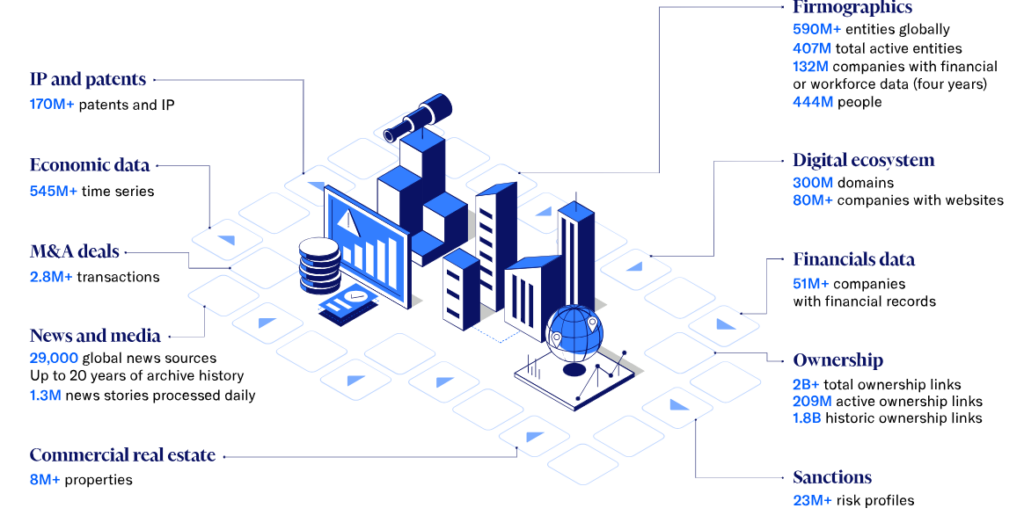
Source: Moody’s
The platform combines several critical analytics applications, including Risk Modeler, ExposureIQ, UnderwriteIQ, and TreatyIQ.
These are designed to deliver hazard modeling, loss estimation, and continuous exposure tracking.
One standout feature is the catastrophe risk assessment.
With global hazard metrics and over 700 model integrations, users can run perils, aggregate loss, and conduct sensitivity analysis.
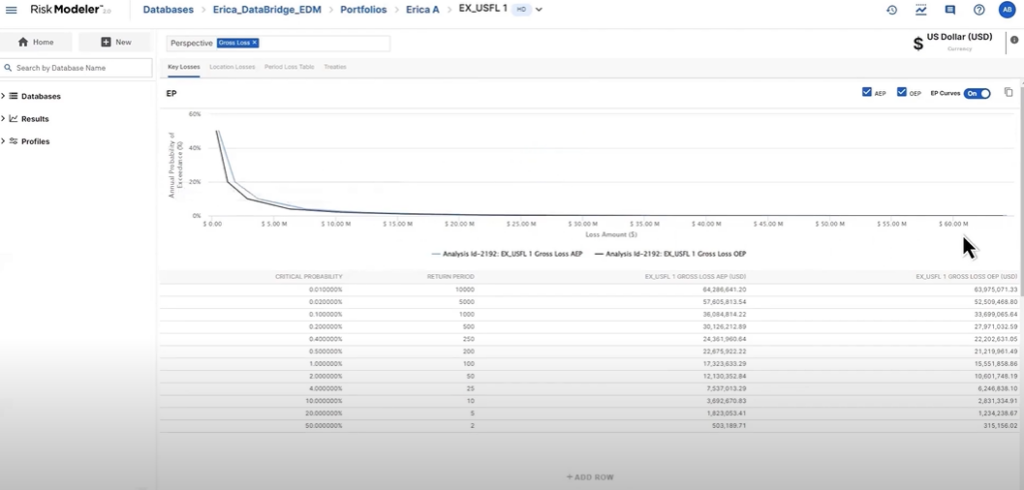
Source: Moody’s – Insurance Solutions on YouTube
Modeling can be embedded into workflows using APIs and Open Modeling Engines, while Risk Data Lake provides a centralized data layer for enhanced visibility and decision-making.
Moody’s also provides supplier risk management solutions through its broader Analytics arm, including due diligence, performance, and cybersecurity scoring.

Source: Moody’s
Since it leans heavily on hazard data and exposure modeling, the platform doesn’t come with real-time cyber threat monitoring capabilities, mass alerts, and integrated remediation workflows.
Limited insight into the user interface and usability (outside of marketing screenshots and videos), no user reviews specific to IRP, and no pricing information are also likely to be considered shortcomings to some companies.
Still, if your primary need is advanced modeling, analytics, and exposure-driven risk quantification, Moody’s remains a serious contender.
Seerist leverages both AI-driven open-source intelligence and a network of expert analysts to deliver risk insights across physical, geopolitical, supply chain, and reputational domains.
The platform ingests data from millions of sources, including over 200,000 relevant news and social media reports daily, to power its core features showcased in the video below:
Source: Seerist on YouTube
Seerist’s Pulse AI enables users to zoom in on geopolitical and security stability of any region and detect emerging risk indicators and hotspots while mapping larger trends.
The interface is packed with data, including a color-coded overview of risk ratings based on categories like political, operational, general, and cybersecurity.

Source: Seerist on YouTube
Advanced event triage enables you to filter and validate incidents easily, as well as assign appropriate severity/risk context.
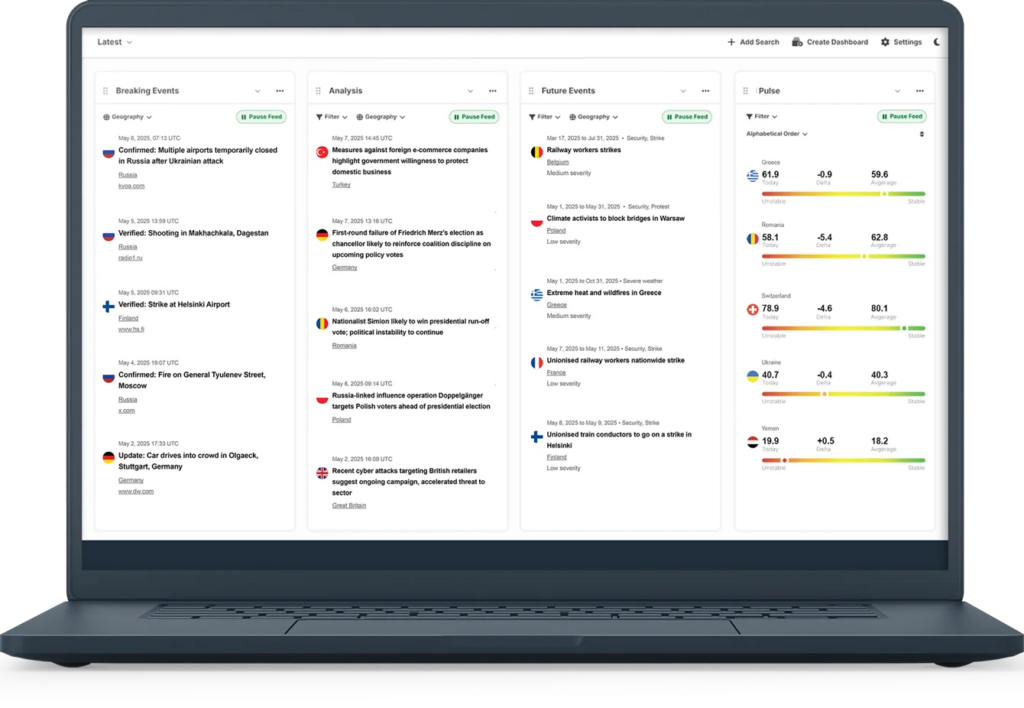
Source: Seerist
All in all, Seerist supports 24/7 global monitoring and is tailored for security, travel risk, supply chain, and asset protection teams.
Its key limitations include more modest coverage in niche commercial data compared to tools like Veridion or Moody’s, as well as less built-in workflow orchestration.
Pricing is not publicly available, but you can get a helpful preview of the features and capabilities included in each plan.
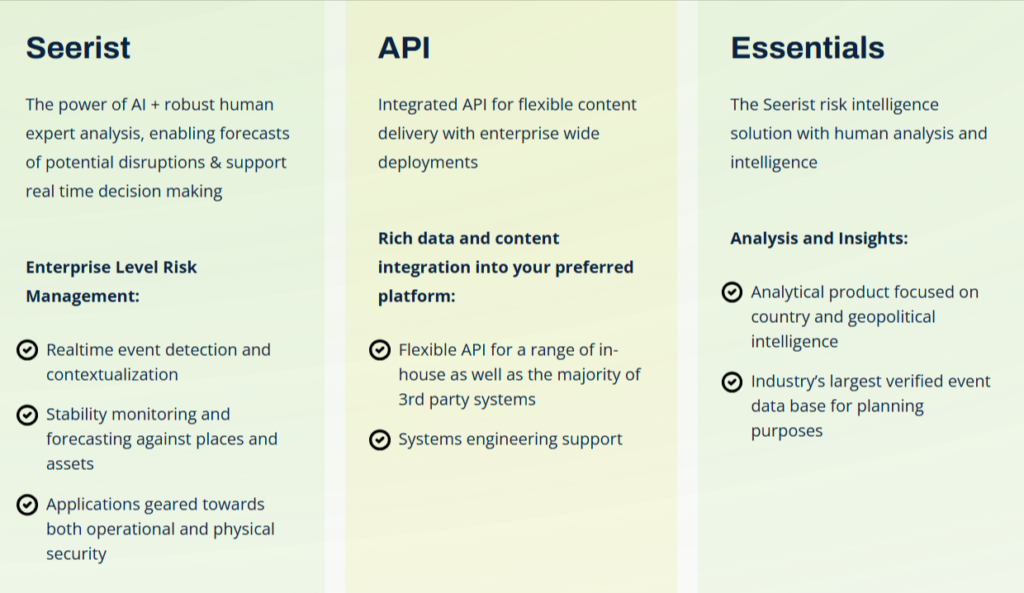
Source: Seerist
If your priority is real-time threat resolution, geopolitical and physical risk monitoring, or integrating human-verified context with AI, Seerist is a compelling option.
AlertMedia is a risk communications and threat intelligence platform aimed at protecting employees, assets, and operations through real-time alerts and incident response workflows.
With the latest updates to its Risk Intelligence suite, AlertMedia now provides AI-curated threat feeds, with early warning signals, narrative monitoring, and more advanced threat workflows.
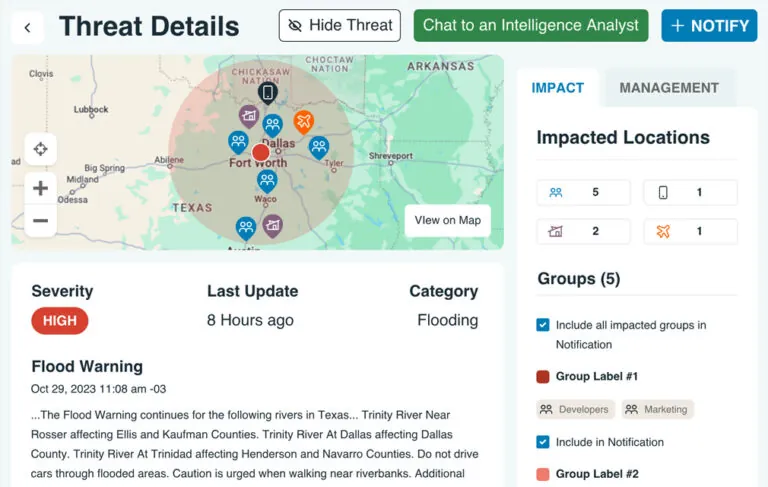
Source: AlertMedia
The platform relies on fewer data sources than most of the solutions on the list.
Still, each threat log enables users to seamlessly connect with AlertMedia’s Global Intelligence team and get expert insight via 24/7 live chat.
In terms of incident management, users can also make use of rapid deployment templates, assign incident-specific tasks for clear risk ownership, and create detailed notifications.
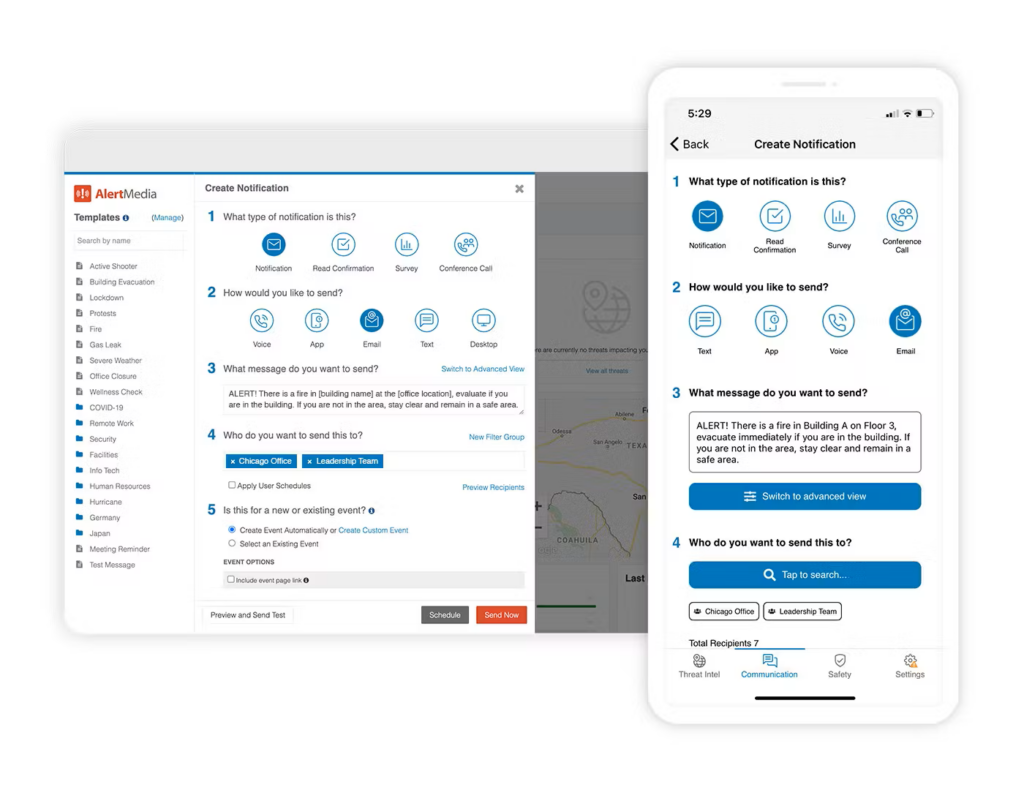
Source: G2
Specific features like lone worker safety monitoring are perfect for companies that want to enhance safety and gain a centralized view of all incoming and outgoing communication, as well as related reporting.
All these capabilities underline the platform’s focus on timely alerts and mass notification systems, rather than long-range predictive modeling offered by more analytics-heavy platforms.
Still, reviews show that AlertMedia excels in the areas it specializes in.
Both G2 and Capterra users praise the tool’s overall ease of use and customer service, but as one reviewer notes, this comes at the expense of limited customization and functionality.
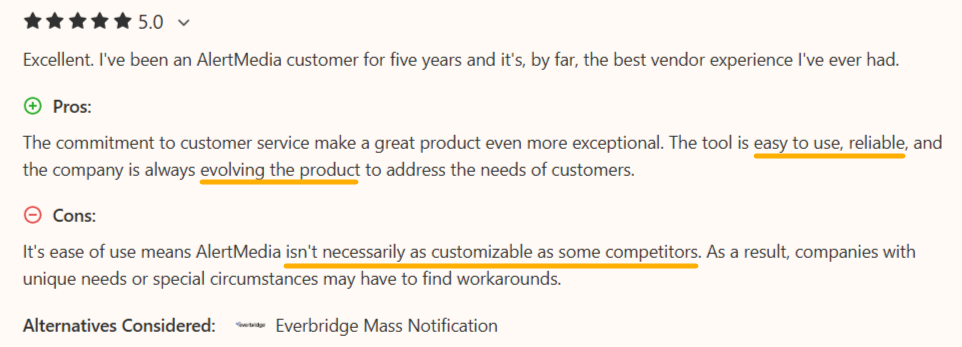
Source: Capterra
The solution’s value for money is another common point of praise, but you’ll still need to request a quote to get a better sense of the pricing.

Source: Alert Media
To sum up, if your priority is real-time warnings and seamless communication of emerging threat contexts, AlertMedia is a strong player to test for your use case.
Resolver is an enterprise risk intelligence and GRC platform designed to connect risk detection, remediation, and compliance workflows in one environment.
Following Kroll’s acquisition, the platform integrates expert-led threat intelligence data and forensic expertise, giving users broader visibility into essential risk areas.
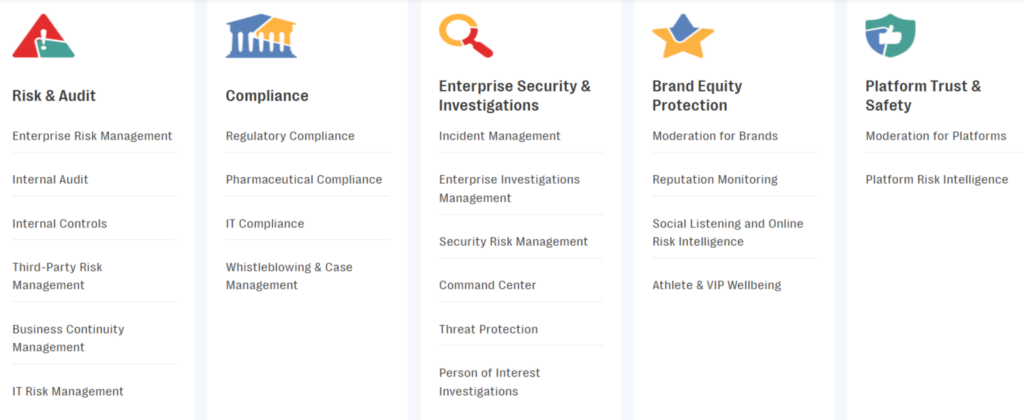
Source: Resolver
With core modules centered on Risk Management, Incident Management, and Internal Audit, Resolver offers an intuitive interface for tracking open incidents and spotting trends.
Users can design and assign risk ownership workflows, automate follow-ups, and visualize trends through configurable dashboards and risk matrices.
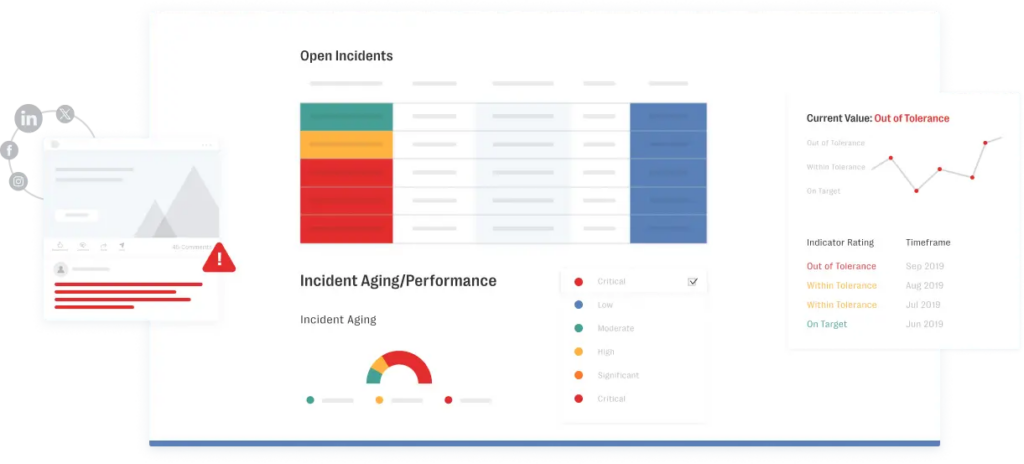
Source: Resolver
You can build or import risk and remediation plans tailored to your industry and specific business needs for maximum relevance and compliance.
Compared to more alert-focused tools like AlertMedia, Resolver offers more depth in risk quantification and audit alignment, as well as advanced collaboration and reporting tools.
Detailed graphics and reports enable enterprises to trace how an incident affects corporate controls, financial performance, or compliance metrics.
This includes executive dashboards that present aggregated insights on residual risks, loss events, and open issues.
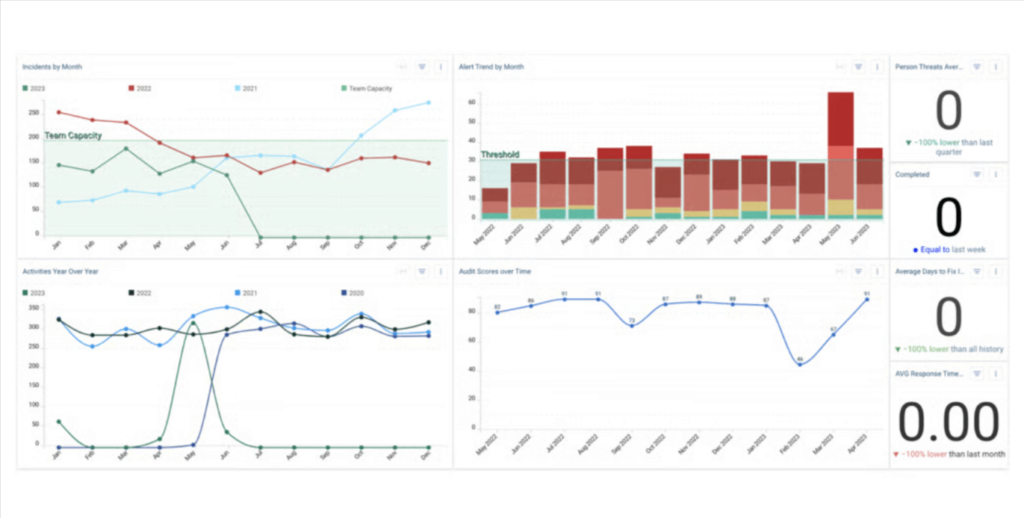
Source: G2
While reviews frequently highlight Resolver’s flexibility and strong analytics, some users note that reporting features still lack intuitiveness.
Others point to the complex and time-consuming implementation in general.
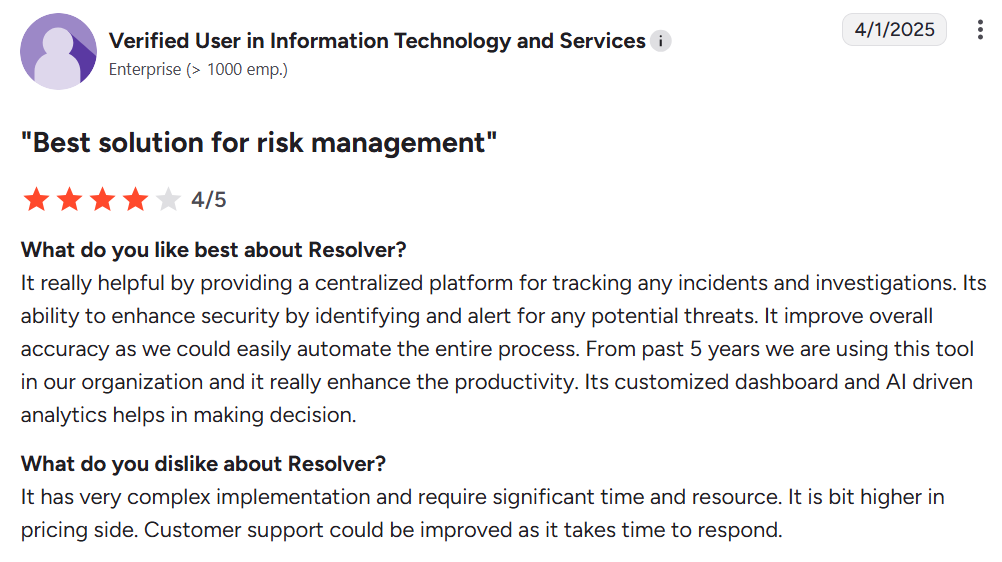
Source: G2
Capterra lists the starting price at $10,000 annually, but it’s best to reach out to Resolver directly for a more precise pricing based on deployment scope and user tiers.
All in all, if your organization’s goal is to connect real-time intelligence with internal controls and remediation workflows, Resolver delivers an adaptable and audit-ready foundation.
Everbridge Risk Intelligence is a key module within the Everbridge 360 ecosystem that provides real-time, precision risk monitoring, analysis, and alerting.
It’s powered by the Risk Intelligence Monitoring Center (RIMC), which ingests thousands of vetted data sources across 100+ risk categories and combines machine learning and AI with human analyst verification.
Source: Everbridge on YouTube
Some of the key features include targeted real-time alerting, supply chain risk monitoring, and dashboards that ensure and enhance situational awareness about events as they unfold.
Users can easily configure automated escalation workflows and assign risk thresholds for specific locations or assets.
Moreover, Everbridge integrates this intelligence with its wider Critical Event Management suite.
For example, real-world risk intelligence feeds can tie into the Visual Command Center and crisis communication tools to trigger key workflows and keep everyone in the loop.
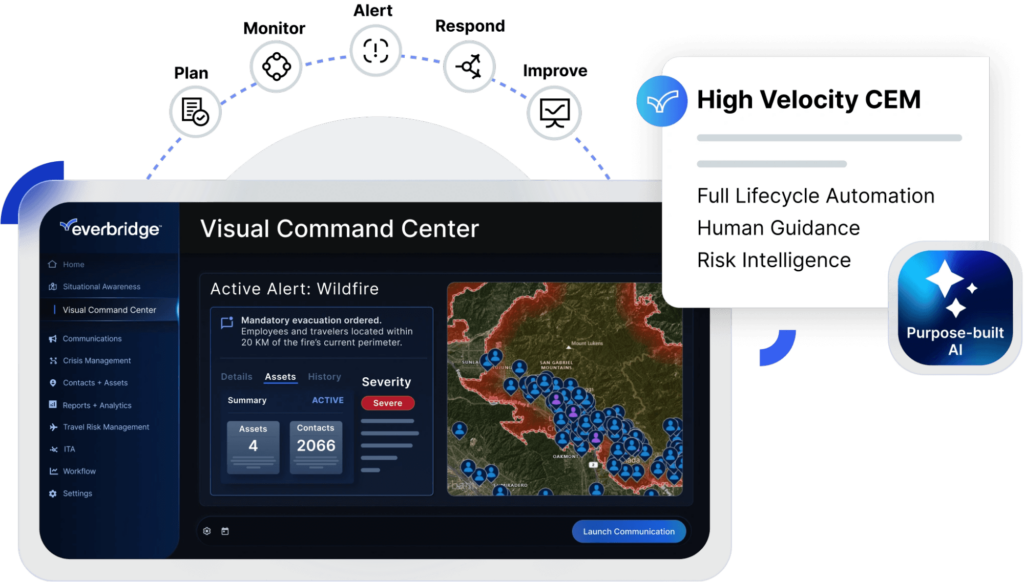
Source: Everbridge
The same High Velocity CEM framework also supports detecting, analyzing, and responding to cybersecurity incidents.
With it, users can monitor cyber-attack patterns, leverage threat intelligence for early detection, and move toward swift mitigation.

Source: Everbridge
While there are no reviews for the risk intelligence module specifically, the users consistently highlight usability and alerts-related features, but also integration issues and inefficiencies.

Source: G2
Pricing for separate modules isn’t listed, but you can check out the features included in different Everbridge 360 plans here.
In short, Everbridge Risk Intelligence is a comprehensive, scalable option for real-time risk intelligence management and critical communications that’s worth exploring.
Every platform we covered in this article brings a distinct set of strengths to the table, from vast data coverage to configurable alerts and specialized workflows.
But screenshots and feature lists only reveal part of the story.
Requesting demos, testing dashboards, and exploring real-world workflows with your team is the only way to fully assess potential solutions.
After all, any risk intelligence platform can highlight threats, but not all solutions will help you build organizational resilience.
So, leave no stone unturned, and invest in a software that will grow with you.